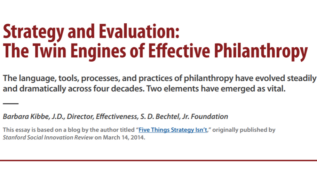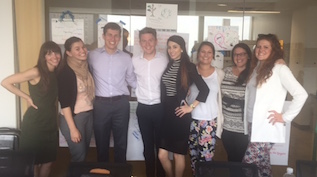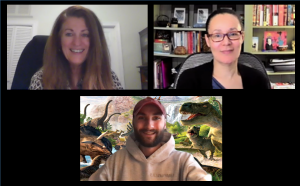- Capacity Building
- Collaboration
- Communication
- Field Building
- Funder Approach
- Outcomes & Impact
- RFPs & Competitions
- Sustainability
- Transparency
- Arts & Culture
- Civic Engagement
- Community Development
- Economy & Workforce
- Emergency & Disaster
- Environment
- Human Rights
- Peace & Conflict
- Science & Technology
- Candid Features
- Case Studies
- Curated Content
- Guided Reading
- Infographics

Conducting a Meaningful Site Visit
A site visit can be one of the most important tools you use, as a grantmaker, in determining your ultimate funding decisions. For example, an in-person look at a potential grantee’s activities can complement a grantee’s written proposal and give you a clearer picture of their request. In fact, site visits can be one of the most interesting parts of the grantmaking process.
What makes a site visit meaningful? Careful preparation, mutually understood goals, a willingness to see the event as part of an ongoing relationship. So how can you be a "good guest" while conducting a structured, but not stifling, site visit? Here grantmakers offer some helpful advice for:
"It's not surprising to feel a little nervous about site visits. One way to orient yourself is to put yourself in the shoes of the applicant and imagine how you'd like to be treated. Often, puzzles about what to say or how to say it will become immediately clear."
— A grantmaker recalling a first experience with site visits
Managing Your Role
Since the business of making grants primarily involves establishing a relationship between the grantor and the grantee, grantmakers often conduct site visits precisely to develop firsthand relationships with leaders and organizations in the communities and fields on which they focus. As such, a site visit can serve as an open-ended interview that allows you to ask pressing questions you may have and let potential grantees discuss the things they love to do. Talking at length and in depth with applicants about their work, and making certain they understand the fundamental purposes of your grant-making program, can also sometimes lead to exciting new ideas.
It can be a mistake, though, to think of a site visit as a discrete, one-time-only event. Site visits and one-to-one conversations are more likely to be continuing activities — at least with organizations directly involved in your program areas. Consequently, you may decide to make your first site visit to some organizations before you circulate a request for proposals, as a get-acquainted step, or as an element of your overall reconnaissance. Later, another visit may be part of your consideration of the group’s proposal. If you decide to award a grant, there are likely to be other visits — within reason — down the road, either to monitor the grant or maintain good relations.
Bear in mind that few organizations turn down a funder’s request for a meeting. They may be in the midst of their busiest season, rushing to prepare a proposal for another funder, or simply overwhelmed with work — they’ll probably still set aside two hours for you. As valuable as site visits can be, therefore, it’s important to make sure you’re not imposing on the organization’s time or distracting its staff. Remember: the organization is not likely to tell you — at least at first — that your request for a meeting comes at a bad time. You need to be alert and sensitive, and hope that at some point the group feels free to be more candid with you about its schedule.
Before You Visit
If the site visit is a first contact, do some homework. If you have not yet received a proposal from the organization, visit its Web site, if one exists, or research its area of work. This preparation allows you to use the time you spend with potential grantees efficiently, to ask pertinent, informed questions, and to understand what they’re trying to accomplish.
Even if the contact isn’t a new one, prepare yourself and the grantee before the visit. Be thoughtful and clear. For example, you might explain that you want to learn more about a particular aspect of the organization’s work. In any case, let them know how much time you have, and whether there are particular people or activities you would like to see.
Formulate some preliminary questions — but be careful of coming up with a long list. Narrow it down to the three most important ones, so as not to overwhelm your host. Notify the potential grantee of your questions ahead of time. You might also suggest that the organization send you an agenda of its own for the visit.
If possible, schedule site visits at times when you can observe some type of program activity. It helps to experience the work of the potential grantee firsthand.
While it can be helpful to conduct your visit with other staff from your foundation — the added perspective may be valuable — remember that having too many additional people can make it hard to have an informative, relaxed conversation.
Be aware that a site visit is a very important event to potential grantees. They will quite likely put a lot of energy into planning it and will hope to have your full attention. Difficulties in scheduling can create a misleading impression, as one grantmaker learned: "I remember a time when one of our team had to leave after half an hour. It wasn’t disrespectful; it was just someone juggling a tough working schedule. But it seemed as though perhaps we weren’t really that interested."
During the Visit
Begin by reminding people of the reason for your visit and about your role. You may have explained these points already, but nonprofits often play host to visitors, and may not remember what you told them. Be sure they understand that you’re there not only as an interested individual, but as your organization’s representative.
Since everyone's time is scarce, you may want to focus on what you most need to know to make a good grant, and on matters that call for the prospective grantee's impressions, interpretations, and personal reflection. In other words, the site visit is not usually the best time to bring up small, detailed matters that may require the applicant to do research or analysis. It is an opportunity to get to know the organization in a more personal way than is possible on paper
As the Visit Concludes
Don't forget to use the visit as an opportunity to expand your knowledge of the broader community or field. Ask applicants for suggestions about other organizations or activities that you should be looking at, or other people you should get to know.
Leave room for excitement: surprisingly good things can happen during a site visit. "I remember one visit," notes an experienced grantmaker, "when, after about an hour-and-a-half of talk and examination of the premises, the prospective grantee deferred going to another meeting so he could fill us in on his ideas for several different possible grants. It was a lively discussion, and I think curtailing it would have curtailed the making of the grant. You have to leave room for excitement."
And a final note. If the first one or two visits start off stiffly, don't worry. It takes more than an hour or two, and often more than a single visit, to establish the kind of trusting, open relationship in which a real exchange of ideas — the "excitement" — can take place.
Learning from Site Visits (Funding Community Organizing) Managing Expectations: Site Visits (Saying Yes / Saying No)
Takeaways are critical, bite-sized resources either excerpted from our guides or written by Candid Learning for Funders using the guide's research data or themes post-publication. Attribution is given if the takeaway is a quotation.
This takeaway was derived from Building Community Inside and Out .
Content type
Related content, your candid learning for funders.
- Registration
- Content Feeds
- About the Website
- About Candid Learning for Funders
- Journal Guidelines

- Donor Advised Funds in San Diego
- Donor-Directed Endowments
- Nonprofit Agency Funds
- Donor Stories
- Advancing Education
- Supporting Our Heroes (The Patriots Connection)
- Building Healthy Communities
- Grant Stories
- Charitable Special Assets Fund
- Legacy Council & Planned Giving for San Diego
- Professional Financial Advisor Listing
- Board of Directors
- Community Foundation
- Financials & Reports
- Investment Performance
- Fundholder Portal
The San Marcos COVID-19 Community Grants Program awards grants to support San Marcos residents affected by COVID-19. Learn more
Donors: How to Conduct a Successful Site Visit at a Non-Profit

Questions to Ask Prior to Visiting a Nonprofit Organization You’re Considering Supporting
A site visit to a nonprofit you’re considering supporting is extremely helpful and informative. Nonprofits are serving diverse populations and communities, sometimes the best way to understand them and how they operate is in person.
Why should you request a site visit to the Organization?
Going to visit an organization you are considering giving a grant/donation to gives you the opportunity to get up an close and personal view of the organization and the people who deliver the services. That personal connection can make all the difference in a decision to support or not. Whether you’ve required a grant application/proposal or not, site visits give you time to see the program in action (if possible), get to know the leadership of an organization and ask questions that weren’t answered in a proposal or prior conversations.
Okay, we’ve convinced you, you’re doing a site visit to the nonprofit organization. Let’s put some structure around it so everyone’s time is used wisely.
Be prepared – Look at the organization’s website and get to know what they do. Let the organization know why you are interested in their work and what you expect to learn on the visit so that staff is prepared when you arrive. If the organization provides any materials ahead of the site visit, be sure to spend time reviewing it.
Plan questions ahead of time – see our list of sample questions and what to look for in their responses. Of course, other questions might come up when you get there but having somewhere to start or go back to is extremely helpful to make sure the visit stays on track.
Identify risks and concerns and address them during the visit . If the organization provided materials (a proposal, grant application, program summary) that needs clarification or you have questions regarding something you saw on their website or on the 990 (which you can access on Guidestar.org), site visits are the perfect time to ask clarifying questions.
Be respectful of the organization’s staff time . Try to limit the visit to just one hour. If you think of suggestions and introductions in the community you can make, include them in a follow-up email after the visit. We find it best to let the organization guide the visit.

Sample Questions to Ask Prior to Visiting the Nonprofit
- What difference will a grant/donation for this project make to the community? What long-term outcomes can be anticipated?
What you want to look for: Forward-thinking and longevity of programs show that the org has done their research and know the needs of the community and how their programs can address those needs.
- What are the potential challenges or barriers to accomplishing the project?
What you want to look for: We all know that most things don’t go according to plan and almost always hit some sort of speed bump. Orgs that have anticipated those challenges will have a Plan B if/when they face them.
- Will the project be able to go forward if I/we do not fund it? How would the project change if your organization received a grant/donation less than requested?
What you want to look for: Programs developed based on needs in the community. Knowing that the program will move forward with or without your funding shows the commitment of the organization to the program’s success. It’s also important for the longevity of an organization to demonstrate diversity in revenue sources.
- Elaborate on ways the project might connect or partner with other community organizations.
What you want to look for: There is strength in numbers and resources. Orgs open to collaboration with their community partners shows they are willing to play ball and do what it takes to address the community’s needs.
- Is your organization on track financially for the current fiscal year?
What you want to look for: Is the org facing bigger financial issues that they haven’t shared? Are they operating at a deficit? If they asked for a donation for a specific program, would unrestricted operating support be better? Do they need to address capital improvements before they can effectively serve the community? These are all good things to know before making your contribution.
- What, if any, role do volunteers play in this project?
What you want to look for: Do they have the support of the community? Are there opportunities for donors to get involved ?
- How active and involved is the board of directors?
What you want to look for: What does their leadership look like? What percentage of the Board of Directors support the organization financially?
- What other organizations are addressing this need and how is your program different?
What you want to look for: Do they understand the landscape they’re working in? Is there an opportunity for collaboration with other nonprofits? We believe that nonprofits collaborating help share learned lessons and resources for more effective programs and greater impact.
Have questions about which nonprofits to support or want to stay up to date with RSF Foundation? Sign up for our newsletter!
One thought on “ Donors: How to Conduct a Successful Site Visit at a Non-Profit ”
Great content! Super high-quality! Keep it up! 🙂
Comments are closed.
Read Related Posts
Podcast: live local, give local with chris sichel, why matching grants work, rancho santa fe women’s fund – above and beyond campaign.
- Donor Advised Funds
Join the many philanthropists making an impact with their charitable giving through donor advised funds at the Rancho Santa Fe Foundation.
- Learn More -
- Endowment Funds
Build a sustainable future for your nonprofit or a nonprofit you support by establishing an endowment fund at the Rancho Santa Fe Foundation.
Discover all the ways to give and receive grants through charitable funds and programs at the Rancho Santa Fe Foundation.

- How We Invest Charitable Funds
- Professional Advisors
- Community Impact Grants
- The Patriots Connection
- VisionNow Donor Program
- RSF Women’s Fund
- Financials & Reports
- In the News
- Privacy Policy

Tax ID #95-3709639
Privacy Overview
[ Placeholder content for popup link ] WordPress Download Manager - Best Download Management Plugin
Foundant Technologies
Successful Site Visits: 7 Tips from Funders
- Be prepared to explain the project (know the budget, work plan, organization’s history, similar projects, etc.). Brief staff on the project so they can be prepared to answer questions as well. And be sure everyone is aligned on the details so that all can speak with “one voice”.
- Have relevant supporting materials on hand for easy reference, and be sure to follow up on questions or send additional information if needed. Do not give the funder excessive materials, a one-page fact sheet is enough.
- Schedule ample time for the visit, but do not provide an extravagant lunch – it is too costly and time-consuming. Light refreshments are a better option.
- Make a strong case for the need for the project and why the organization is uniquely positioned to deliver on the project. Why should they fund you and not the other 100 applicants?
- Give a tour and/or show the project to the funder. Remember the value of a positive visual impression. Be sure the office, building, and grounds are neat and uncluttered.
- Do not hide any bad press or challenges the organization is facing; be upfront so that the funder can be of assistance. In most cases, they may already be aware that the organization has had financial struggles.
- Allow the funder to interact with the project’s target audience (e.g. youth, volunteers, etc.). This is perhaps the most rewarding aspect of a site visit from the funder’s perspective because it truly shows the impact of their grant award.
Margit Brazda Poirier, GPC, M.S. is Owner and CEO of Grants4Good LLC® , a grant consulting company that specializes in online training and grant strategy. www.grants4good.com
- CommunitySuite
- Grant Lifecycle Manager
- Scholarship Lifecycle Manager
By Organization Type
- Community Foundations
- Grantmaking Foundations
- Scholarship Providers
- Coffee Talks
- Client Stories
- Support Hub
- Compass Community
About Foundant
- News and Press
Foundant Technologies, Inc. 143 Willow Peak Drive Bozeman, MT 59718 (877) 297-0043
Subscription Preferences
Site Visits: A Guide for Nonprofits

Our last blog post looked at site visits, in particular how foundations can help make them more productive. In this post, we return to site visits from the nonprofit’s perspective, and answer some frequently asked questions from our nonprofit colleagues.
I APPLIED FOR A GRANT AND NOW THE FOUNDATION IS REQUESTING A SITE VISIT. WHAT DOES THIS MEAN AND WHAT DO THEY EXPECT?
Site visit is a term that can sound an awful lot like a health inspection or tax audit. Breathe. Here is a chance to show off your work, and introduce members of your team to a potential donor.
HOW DO I PREPARE MY STAFF FOR A SITE VISIT?
Preparation is key to a successful visit. Here are some tips:
- Think about your staff and volunteers, and who is comfortable speaking in groups and connecting with people. Choose carefully. And pick only a few—too many people each trying to explain the agency or program can get confusing.
- Ask the foundation if there is any specific program or issue they’d like to learn more about. This will also determine who participates in the site visit.
- Ask the foundation how much time they wish to spend with you. Expect about an hour.
- Reserve a quiet area for discussion. If your office is one room, and it’s always noisy, meet first at a local café.
- Encourage your staff to develop speaking points. Do a mock site visit if needed.
- Learn about the foundation’s past grants and current interests.
- Confirm two days before, and offer parking advice if needed.
SHOULD I HAVE THE FOUNDATION VISIT A PROGRAM IN ACTION?
Yes if a) seeing the program in action would help build your case for funding, and b) visitors would not cause a disruption nor be inappropriate. Always inform program staff, volunteers and participants in advance that guests will be attending. Allyson Halpern, the Development Director at 826 Valencia says, “When people see our students working alongside volunteer tutors, helping them develop their writing skills, confidence and finding their voice, that’s when folks really ‘get’ us.”
OUR BUDGET HAS CHANGED SIGNIFICANTLY FROM LAST YEAR. HOW DO I EXPLAIN THIS?
Every organization has its struggles. Be proactive about discussing any major changes in the organization including funding status, new leadership, and overall achievements and challenges. Funding can shift from year to year, as can an organization’s priorities. A foundation grant is not a reward for a job well done; it is meant to help an organization achieve its goals.
SHOULD I SHOW OUR NEW VIDEO AT THE SITE VISIT?
No. A site visit is valuable face-to-face time with a potential donor. Send them a link to the video either before or after the site visit. Same goes for any marketing materials including your annual report.
I’M TEXTING YOU FROM THE BATHROOM. THEY JUST ASKED ME A QUESTION AND I DON’T KNOW THE ANSWER. HELP!
Relax. You are not expected to know everything. But you are expected to ask for help when needed and find out answers to questions. So tell them you’ll find out the answer and get back to them soon. Now get out of the bathroom!
WHAT HAPPENS AFTER THE SITE VISIT?
Within 24 hours, send an email thanking your guests for coming. Include any follow-up information (like the answer you didn’t know to that question!) If you’re not clear on next steps, ask about the foundation’s timeline. Thank your staff and volunteers as well. Tell them you know site visits can feel time-consuming and disruptive, but relationship-building is critical to the health of an organization.
Good luck, and remember to leave space in the conversation for questions and contemplation. And wear comfortable shoes, because that’s never a bad idea.
Contact us to discover how we can tailor our services and handpick a team of professional experts to support the specific needs of your foundation.
Our website uses cookies to help provide you with the best experience and personalized content. To learn more please contact us .
Privacy settings.
Decide which cookies you want to allow.
You can change these settings at any time. However, this can result in some functions no longer being available. For information on deleting the cookies, please consult your browser’s help function.
With the slider, you can enable or disable different types of cookies:
This website will:, this website won't:.
- Remember which cookies group you accepted
- Essential: Remember your cookie permission setting
- Essential: Allow session cookies
- Essential: Gather information you input into a contact forms, newsletter and other forms across all pages
- Essential: Keep track of what you input in a shopping cart
- Essential: Authenticate that you are logged into your user account
- Essential: Remember language version you selected
- Functionality: Remember social media settings
- Functionality: Remember selected region and country
- Analytics: Keep track of your visited pages and interaction taken
- Analytics: Keep track about your location and region based on your IP number
- Analytics: Keep track of the time spent on each page
- Analytics: Increase the data quality of the statistics functions
- Advertising: Tailor information and advertising to your interests based on e.g. the content you have visited before. (Currently we do not use targeting or targeting cookies.
- Advertising: Gather personally identifiable information such as name and location

Affordable Grant Writing for Nonprofits
1-866-7GRANTS
- May 9, 2023
From Panic To Prepared: How To Prepare for a Site Visit From a Grant Maker

Are you gearing up for a site visit from a grant-maker? The anticipation can be both exhilarating and nerve-wracking.
You want to ensure you present your organization in the best light possible, but where do you begin?
Preparing for a successful site visit takes more than just tidying up your space. It takes a careful and strategic approach to ensure you make the most of this critical opportunity.
But don't worry; everything you need is right here! Keep reading for expert tips and tricks to help you ace your next grant prospect site visit and secure the funding you need to make a real impact in your community.
Preparing for a Site Visit from a Prospective Grant-maker
You'll be ready to impress those funders with the right mindset and some strategic planning.
First, though it may seem obvious—ensure your facility is clean and tidy! A presentable environment can go a long way in creating a positive impression.
Next, put together and rehearse your presentation.
Presenting Your Nonprofit
When presenting your nonprofit organization to a prospective grant-maker during a site visit, it's essential to be prepared and organized. Here are some tips to help you make a great impression:
Gather all the necessary information and materials, such as program descriptions, budgets, and impact data.
Anticipate any questions the funder may have about your organization and its work, and proactively answer them in your presentation.
Be transparent and honest about your challenges and limitations, as well as your successes and achievements.
Showcase your passion and commitment to your cause with real-life examples.
Share recent and historical statistics to help the funder understand the significance and impact of your organization's work.
So now that your facility is shining and your presentation is polished - it's time to craft the perfect agenda.
Crafting the Perfect Agenda
Identify the main objectives of your visit and the key stakeholders you'll be meeting with.
Prioritize the most important meetings and create a timeline for each one.
Consider the time available for each meeting and include breaks to avoid getting overwhelmed.
Leave some wiggle room in your schedule if schedules need to be adjusted or unexpected issues arise.
Making the Most of Your Time
Showcase your mission.
During the visit, take the opportunity to highlight your nonprofit's mission and the unique ways you are addressing the needs of your community. Use real-life stories and examples to illustrate the impact of your work.
Engage with the funder
Don't hesitate to ask questions and engage in dialogue with the grant-maker. This is your chance to build a relationship and demonstrate your commitment to the funder's priorities. Be sure to follow up after the visit to thank the funder for their time and reinforce your nonprofit's interest in their funding opportunities.
The Power of Gratitude: Following Up with a Thank-You Note
Following up with a thank-you note after a site visit can help solidify the relationship with a prospective funder and demonstrate your commitment to working together. Here are some tips on how to write a thank-you note to grant-makers that stands out:
Use a personal greeting: Start with a warm and personal greeting to show appreciation for the prospective funder's time and attention.
Be specific: Mention standout points from the meeting to show your engagement and attentiveness.
Express gratitude: Thank the funder for their interest in your organization and considering your work for funding.
Highlight commitment: Emphasize your organization's commitment to your cause and eagerness to work together.
End with a call-to-action: Close by expressing interest in further communication and inviting the funder to reach out with any questions or concerns.
Remember to keep the note concise, sincere, and professional. Following up with a well-crafted thank-you note can leave a lasting impression on the funder and increase your chances of securing funding.
When crafting your note, remember to keep it concise, sincere, and professional. With these tips in mind, nonprofits can feel confident and excited about site visits— and turn them into successful partnerships.
What's your go-to strategy for wowing a potential funder during a site visit? Share your best tactics in the comments below!

Meet the Author - Kristin Chute
Kristin Chute is a freelance writer with a passion for helping nonprofits increase their reach and impact. She has written for companies offering SaaS solutions, nonprofits directly, and donor loyalty programs.
Kristin believes in the power of nonprofit organizations to change the world. With expertise stemming from her career and personal connection to volunteering at her childhood summer camp, she shares insights to help nonprofits increase their reach, engage supporters, and amplify fundraising efforts.
- Grant Writing
- Fundraising
- Nonprofit Development
Recent Posts
How Can I Thank a Foundation Grant-Maker?
How To Secure a Grant for a Nonprofit
How to Talk to a Grant Administrator For Better Grant Requests
Comentarios
It’s a New Year – Are You Planning Site Visits to Current or Prospective Grantees?
- Joanne Florino
- Donor Intent
- January 23, 2023
“ Protecting Your Legacy, ” Philanthropy Roundtable’s guidebook on donor intent , advises donors to “know your grant recipients.” To do this effectively, the Roundtable advises making site visits, among other things.
Many foundations and individual funders regard a site visit as a critical element of due diligence before awarding a grant, particularly when the applicant or the program to be funded is not familiar to the grant maker. On some occasions, however, site visits may be helpful in enriching existing relationships, particularly when there are leadership transitions on either side. In-person site visits were typically abandoned in 2020, given the COVID-19 pandemic, and even in 2021 were more likely to be made virtually, if at all.
With the emergence of new nonprofits in response to the pandemic, to the disruption of K-12 education and to other social issues – along with an increase in nonprofit mergers, dissolutions and staff shortages – donors may decide site visits are again not only desirable, but necessary. What then are the optimal circumstances for in-person visits and how should donors ensure such visits are beneficial to both parties involved?
Funders typically make site visits to see a program in action, so schools, museums, day care facilities, food pantries and youth and community centers are common candidates. There are times, however, when it is preferable for donors to visit a nonprofit organization’s office, particularly to protect the health or confidentiality of vulnerable clients – in a domestic violence shelter, for example – and funders should be sensitive to those situations.
Because a grant maker’s request for a site visit inevitably raises expectations at the nonprofit in question, it is wise to limit such requests to organizations from which you have already received a grant application and in which you have a genuine interest. For a potential grantee, a site visit – despite the potential benefits – will be time-consuming. Donors can help ensure a more productive site visit in a number of ways:
- Make the executive director or CEO of the organization your first point of contact. That person will likely choose to be present for the site visit and can also help you identify other key individuals who should be present, including board members. In addition, you should identify those who will be attending on behalf of the grant maker and keep this group small.
- Provide a brief outline of your mission and why you are drawn to the work of the organization and, if relevant, what specific program or project appeals to you.
- Where appropriate, ask for an opportunity to see service delivery in action. Classrooms and job training programs, museums and libraries, some health care and research facilities and community centers are among the venues where this may be possible.
- Work with the nonprofit to plan the site visit agenda to understand each other’s priorities.
- Read the grant application thoroughly before you visit so you can avoid asking for information that has already been provided. Instead, use this opportunity to understand the values and personal passions that drive the organization as well as the challenges it is facing.
- Do ask about financial sustainability, staffing needs, overall capacity to deliver programs and increases or decreases in community need for services.
- Do ask why things are done the way they are and what sort of changes the organization sees ahead.
- Do ask questions about board engagement and any needs the organization has in this area.
- Do ask questions about the organization’s impact – how evaluation is done and how it affects future service delivery.
- Do ask about client feedback – how it is gathered and utilized.
- Invite questions about your philanthropy and how and when funding decisions are made. The nonprofit folks may hesitate to ask, but they certainly would like to know.
- Be honest if asked for feedback about what you have learned during your site visit. Beyond the more immediate grant decision, you are beginning to build a relationship with an organization that sparked your interest, and your feedback – both positive and negative – will be valuable.
Although a site visit is only one aspect of the due diligence you should perform as a regular part of grant making, it is invaluable in giving a close-up look at a potential or existing grantee. It also reinforces the many other safeguards you employ to protect donor intent and ensure grant compliance. As Keith Whitaker of Wise Counsel Research noted in “Protecting Your Legacy,” “Grant compliance happens best when you have done the work upfront to make sure you’re partnering with an organization that really believes in what you’re trying to do and isn’t just trying to game your system in order to get money. The best compliance is the investigatory work, the due diligence, the time commitment needed to get to know a grantee.”

Let’s Keep in Touch
Our Values-Based Giving Newsletter helps philanthropists and charitable organizations apply their values to their giving and follow the best practices for success.
Grant Evaluation, Proposal Review and Site Visits
- Knowledge Center
- NCFP Knowledge Center—Collections
About this collection: Family foundations are in business to make a difference. This NCFP Content Collection focuses on techniques available for assessing and evaluating the results of your giving, as well as tips, strategies, and sample policies regarding grant evaluation and site visits.
- email Email
Family foundations are in business to make a difference. This NCFP Content Collection focuses on techniques available for assessing and evaluating the results of your giving, as well as tips, strategies, and sample policies regarding grant evaluation and site visits.
Grant Evaluation

Measuring What Counts: Meaningful Evaluation for Family Foundations

The power of taking stock: 5 reasons to conduct evaluations


The Step-by-Step Guide to Evaluation

Impact and Outcomes: from Jargon to Meaning
Hiring an external evaluator.

Strategy and Evaluation: The Twin Engines of Effective Philanthropy
Proposal review.

Best Practices for Assessing an Organization’s Wellness
Conducting site visits.

What Are Some Tips for Creating Virtual Site Visits?

Site Visit Rubric (Dodge Foundation)

Going on Your First Site Visit? 3 Tools for Success

How should our family foundation think about the use of site visits?
Site visit forms and checklists.
See below for a selection of samples from our Policy Central Collection for Grantmaking and Strategy :
- Guidelines for Interactions with Community Based Orgs (Firelight Fdn, 2022)
- Site Visit Tips and Case Studies (Family Foundation Advisor, 2022)
- Site Visit Worksheet (Packard Fdn, 2016)
- Site Visit Evaluation Form (Marksbury Fam Fdn, 2016)
- Dodge Foundation Site Visit Rubric (David Grant, 2015)
- Site Visit Guidance (William J. and Dorothy K. ONeill Foundation, 2011)
- Site Visit Checklist (Leighty Foundation, 2001)
- Site Visit Evaluation Report (Leighty Foundation, 2001)
Receive updates for this collection when new resources are available.
We’re here to equip you with the tools you need to make a meaningful impact. Contact NCFP for support.
Get in Touch
Keep up with trends in family philanthropy. Subscribe to our newsletter.
Gain access to personalized support and a network of peers. Join our community!
This content is available exclusively to NCFP Friends of the Family. To access it, please LOGIN or JOIN THE FAMILY.

How to prepare for a successful foundation site visit
Foundations and other funders may request a site visit before they approve funding for a grant . This is often a typical part of the grant review process for a foundation; others may decide to visit programs on a case-by-case visit.
Site visits are crucial. They give you face time with the funder and allow you to show off the best of your program. A well-written grant can go a long way, but ultimately seeing a program in action pulls at the heartstrings in a concrete way that a paper application just can’t.
You can prepare in several ways for a successful site visit:
1. Ask the funder if there is anything in particular they want to see or experience.
They’ll obviously want to experience the program you’re requesting funding for , but be sure to ask if there is anyone specific they’d like to meet, how many representatives you can expect, and how long they’ll be staying. Get all the details and make sure you have your bases covered.
2. Be prepared.
Refresh your memory by reading the proposal, speak in depth with the program director (or better yet, make sure they are present), put together tear sheets and folders with brochures and more information, and learn everything you can about the foundation visiting. Memorize the names of the people who are coming and if you can, glean some details about their background. Have important staff on call in case a question comes up you can’t answer.
3. Remind the funder of key details.
Funders are reading lots of proposals and doing lots of site visits, so sometimes they mix up the details. Start the visit with a brief overview, and emphasize why your program is important . As the visit progresses, be sure to thoroughly answer any questions the funder may have, even if you’re repeating information that’s in your proposal.
4. Don’t oversell.
Funders want to a true day-in-the-life experience, so don’t worry about flash and glitter. You don’t have to arrange for the kids in your program to put on a special performance, for example, but if something like that is already happening, the funder may be interested. You don’t need to shower the visitor with gifts and put on the strobe lights, but allow unscripted moments of magic to happen. If your guest wants to interact with your clients, let them, though if you know a particular client is difficult and may cause problems, steer them towards another person. Don’t gloss over difficulties your agency may be having, either. You’re asking for money, after all, so don’t be afraid to say so. At the same time, don’t beg.
5. Be enthusiastic.
You’re representing your organization, so drink some coffee and get fired up. Being personable and energetic will go a long way. Ask questions about the foundation’s process and your chances, and follow up after the visit is over. Show you’re invested in working with this funder and that you value their input and their time.
The site visit is an imperative step in building a long-term relationship with a foundation — one that will hopefully grow year after year in terms of dollars.
Interested in learning more about our grant writing services? Contact us .
No Comments
Post a comment.
Notice: It seems you have Javascript disabled in your Browser. In order to submit a comment to this post, please write this code along with your comment: ba0dc1386ddd498348f490a5e768124b
Search The Center:
Member Site Visits
Building relationships with our members.
At the Center, our mission is to help nonprofits build capacity and sustainability. Our site visits are one way we gain insights into the challenges our member organizations face and how we can tailor our support to help.
Even during the pandemic, we continued our visits—in the virtual realm! Patrick Rabiecki , our Site Visiting Ambassador, enjoys meeting with members and also attends member events when possible.
Check out his meet-ups, and consider inviting Patrick to visit your nonprofit!
NOVA ScriptsCentral
This month, Patrick sat down with Joy Reyes from NOVA ScriptsCentral. Founded in 2006, NOVA ScriptsCentral is a nonprofit pharmacy that provides competent pharmaceutical care and supportive services to low-income and uninsured populations in Northern Virginia. They receive health benefits through the Center’s VitalHealth program, as well as actively participating in other Center benefits, such as training courses and Center BINGO. Learn more about this organization and their work by checking out their website .
DC Central Kitchen
Patrick met with Alex Moore from DC Central Kitchen to tour their new facility. As an active Center member for the last decade, DC Central kitchen takes full advantage of Center classes, cohorts and benefits. Their mission is to use food as a tool to strengthen bodies, empower minds, and build communities. The nonprofit provides hands-on culinary job training for individuals facing high barriers to employment, while creating living wage jobs and bringing nutritious, dignified food where it is most needed. Their social ventures include serving scratch-cooked farm-to-school meals in DC schools, delivering fresh, affordable produce to corner stores in neighborhoods without supermarkets, and operating a fast-casual cafe.
Patrick met with Zachary Clark, Executive Director at 826DC. They joined the Center in 2020, after hearing about our Board Match program. 826DC’s mission is to support children with their creative and expository writing skills. They provide tutoring, field trips, after-school workshops, in-school programs, and assistance with student publications. Stop by their storefront, Tivoli’s Astounding Magic Supply Company, where all proceeds go to supporting their writing workshops!
Solar United Neighbors
On Friday, April 8 th , Patrick attended Solar United Neighbors’ webinar “Allegheny County Solar and EV Charger Co-op Info Session”. This virtual info session walked attendees through the advantages of having solar energy in your home or small business, and how their co-ops can help make it possible for anyone. Attendees were able to ask questions from SUN’s panel of experts, in real time.
Scenic America
In March, Center Membership Associate Patrick had a virtual site visit with Scenic America, which has been a member of the Center since 2018. Its mission is to preserve and enhance the scenic beauty of America through promoting government policies that encourage citizen engagement and limiting visual pollution from billboards and wireless telecommunication towers. Check out their website to learn more about their work!
The Alliance for Health Policy
On Friday, January 28 th , Center Membership Associate Patrick attended The Alliance for Health Policy’s virtual event. This was part 3 of a series of webinars that Alliance for Health Policy hosted recently. This one focused on health policy at the state level and provided a round-up of state-level policies enacted during the past few years, focusing on cost containment, complex care, and drug pricing reform.
Western Presbyterian Church
On Sunday, the 12 th of December, Patrick attended Western Presbyterian Church’s virtual Sunday service. They are active Center members and are a congregation devoted to promoting social justice – caring for the poor, disenfranchised communities and being good stewards of the earth. The Church is currently planning for the upcoming Christmas pageant and season.
Virginia Hospital Center Medical Brigade
In September 2021, Patrick visited VHC Medical Brigade’s warehouse to receive a tour and speak with Operations Director, Mary Ellen Gannon. Working in partnership with local service providers and the Honduran government, VHC Medical Brigade works to create healthy and sustainable communities in Honduras. They are currently planning their fall trip to Honduras where they will travel with a group of surgeons to perform various medical procedures for those in need. Having recently joined the Center, VHC Medical Brigade is looking to form new connections that will assist them in their mission.
Gay Men’s Chorus of Washington, DC
In June 2021, Patrick met with Justin Fyala from Gay Men’s Chorus of Washington, DC. GMCW originally joined the Center in 1996. Their mission is to inspire equality and inclusion with musical performances and education promoting justice and dignity for all people. Formed in 1981, they are the only LGBTQ+ chorus in the nation’s capital. They seek to redefine the word “Chorus” through fun, engaging performances that include singers, dancers and storytellers. They specifically travel to areas in the country that have little LGBTQ+ representation, in order to provide education and entertainment in a safe space for everyone. Check out past performances on their YouTube page !
City Wildlife
In May 2021, Patrick was excited to visit a member in-person —the first non-virtual visit in over a year. He met with Jim Monsma, executive director of City Wildlife, who gave him a tour of their facilities. Founded in 2013, City Wildlife is the only wildlife rescue and rehabilitation located in Washington, DC. They take in injured wild animals and, with help from an onsite veterinarian, care for them until they are ready to be released into the wild. City Wildlife joined the Center in 2020 at the recommendation of one of their Board members. They joined to take advantage of VitalHealth, but are also interested in exploring the Center’s many other benefits, including an Instagram Takeover.
McLean Project of the Arts
MPA held their inaugural ArtSprings! Virtual Benefit on April 29, 2021, celebrating MPA and the Gift of McLean Artist Emilie Benes Brzezinski’s Work. Patrick attended the event on behalf of the Center and enjoyed the range of musical guest performers. Nationally recognized media personality Amy Goodman emceed the event, which featured an array of musical performers, including Voices of Classic Soul with Joe Coleman, Joe Blunt, Theo Peoples, The Dave Kline Band, with special guest Senator Tim Kaine, and members of Strathmore Music Center’s Artist in Residence program.
Go2 Foundation for Lung Cancer
In March 2021, Patrick took a trip to the barnyard to sit down with Kristin Bramell, the Director of Philanthropy for Go2 Foundation for Lung Cancer. They work to provide the knowledge and tools needed for anyone at risk for, currently living with, or having survived lung cancer. They also work on the advocacy side to improve access to healthcare for patients. Patrick and Kristin discussed various ways to use their Center membership to help promote and strengthen their mission. These include joining the Center’s cohorts, as well as taking advantage of the Center’s Instagram Takeover feature.

Fair Chance
In December 2020, Patrick travelled back to a time when dinosaurs walked the earth for his sit down with Gretchen Van der Veer and Ann Miles from Fair Chance. Their mission is to provide children and families a pathway out of poverty by strengthening the sustainability and performance of community-based nonprofits who serve this need. They do this in several ways, including a partnership program that provides free management assistance to build leadership skills and strengthen organizational systems and programs. They have been members of the Center for nearly 10 years. We are looking forward to engaging in new ways with Fair Chance in the future!
Humane Farm Animal Care
Patrick met with Mimi Stein from Humane Animal Care, a nonprofit that focuses on the ethical treatment of farm animals who are raised to become our food. They work with farms all over the world to make sure that the animals are treated properly and raised cruelty-free. Mimi and Patrick discussed the difficulties she faces running an organization with a mission that most people don’t want to hear about. The Center was able to work with Mimi to host an Instagram takeover of the Center’s account, to help raise awareness for their cause and how people can help by shopping Certified Humane.
International Campaign for Tibet
Patrick sat down with Ashwin Verghese from the International Campaign for Tibet. This member organization is the largest Tibet support group in the world. They advocate here in America, on behalf of the people of Tibet in their peaceful struggle to preserve their human rights and establish democracy. Having just joined the Center in March 2020, they have only scratched the surface of their Center membership and are looking forward to exploring more.
YWCA National Capital Area
Continuing his 2-fold mission to explore the (virtual) world while also getting to know our members, Patrick and Center team member Aziza braved the wilds of the jungle to sit down with Monica Gray to discuss her organization. With a mission to dismantle the barriers that women and girls of color face in America, YWCA provides invaluable resources for the DC area. Through their advocacy for racial justice, youth development, and career education programs, YWCA is a true leader in the fight for justice for all.
Everyone Home DC
Patrick took a breezy, tropical shores trip to sit down with Kate Akalonu, Director of Strategic Initiatives at Everyone Home DC. They are a nonprofit based in DC, that works to both prevent homelessness for at-risk individuals, as well as help those currently experiencing homelessness. Due to the pandemic, Everyone Home DC found themselves having to rethink their fundraising approach. In response they launched “The September Challenge”. This month-long, very successful series of online fundraising events took place during September. Challenges ranged from Zumba and cooking to Bingo, trivia, and more!
Americans for Peace
Before the pandemic, Patrick had the opportunity to visit the office this member organization. He sat down with two of their staff members for an engaging discussion on their mission, feedback about their Center membership, and ways the Center can help them going forward. Americans for Peace Now was founded in 1981 to help spread awareness in America for its sister organization, Shalom Achshav. It has since developed into America’s most prominent organization of Jewish Americans, working to achieve a sustainable peace plan to the Arab-Israeli conflict. The Center is looking forward to helping them promote their mission through our wide network of nonprofit contacts.
Share This Page:
Supporting economic mobility.
The Center for Nonprofit Advancement had the distinct honor of being able to participate in and…
Honoring Dr. Madye Henson-McCannon’s Commitment to Service
Dr. Madye Henson-McCannon is named recipient of the 2024 DMV Remarkable Winner award, recognizing her…
The Center Celebrates Women’s History Month, 2024
The Center for Nonprofit Advancement proudly celebrates Women's History Month, 2024. Throughout March, we honor…
Username or Email Address
Remember Me
Not a member? Click here to join now

Site Visits: Community Engagement for Better Grantmaking
For community foundations, the importance of making connections to nonprofits and other community partners cannot be understated. Getting to know Alaskan organizations allows The Alaska Community Foundation (ACF) to improve its work, especially when it comes to components of ACF such as funding and grantmaking.
But how do community foundations go about getting to know local nonprofits, especially when “local” means an area as large as the state of Alaska?
Site visits are one way for a foundation to get to know an organization in-person and in-depth. They are a best practice among foundations globally, and present valuable opportunities for both foundation staff and the organizations at the focus of the visit to share each other’s work. A typical site visit involves a tour of the organization’s facility, as well conversation about the organization’s mission and activities. ACF staff also provide time for the nonprofit’s staff to learn more about ACF, which includes general knowledge about the community foundation, but also more specific information such as availability of grants at ACF.
My own experience with site visits has been a valuable one. For the past several weeks Program Officer Penny Gage and I have made site visits to several organizations. To name a few, we visited the Alaska Literacy Program in Anchorage, the Denali Arts Council in Talkeetna, and the Girdwood Health Clinic . At each organization we gathered information about the nonprofit that would have been more difficult to realize via electronic communications. For instance, we found that at the Alaska Literacy Program, “literacy” is broadly defined to include financial literacy, health literacy, and others, especially focusing in Alaska’s refugee and immigrant communities. By visiting multiple organizations in Talkeetna, we learned that Talkeetna has a thriving community of nonprofits that are increasingly collaborating with one another. And in Girdwood, we saw firsthand the impact that ACF funding can have on communities along the Turnagain Arm, where last winter’s lack of snowfall presented significant economic challenges for many organizations.

ACF Board Chair Alex Slivka speaks at the Girdwood Health Clinic on Alaska Day.
The site visits Penny and I conducted weren’t just beneficial for ACF, however; they also presented learning opportunities for the organizations we visited. Each one had a wide range of experience working with ACF, and so each gained different kinds of knowledge from the visits. Some organizations had never heard about our grant programs and are now considering applying. Other organizations had heard about our competitive grants, but had never applied; for these organizations, the site visits provided appropriate support and encouragement. They now can put a face to the name when they approach ACF to partner in their investments, which is something that is so important in a state with a population as small as Alaska.

“Wild Youngers” at the Northern Susitna Institute in Talkeetna having fun!
While site visits are not always convenient, ACF staff members makes their best efforts to incorporate site visits into their travels and day-to-day activities. ACF recognizes that site visits are important resources that allow our foundation to make personal connections to community organizations. With time and opportunity, I can only hope that more and more Alaskan nonprofits may also come to understand the purpose and value of site visits.
Connecting People Who Care With Causes That Matter

- Team Members
- Justice, Equity, Diversity, and Inclusion (JEDI) Statement
- Focus Areas
- Our Approach
- Clients and Funders
- Join Our Team
- Research and Evaluation
- Evaluation Capacity Building
- 10 Steps to Creating an Infographic
- Mindful Leadership
An Evaluator’s Guide to Performing Successful Site Visit Observations
For external evaluators, site visits (e.g. visiting schools) provide an opportunity to experience the activity, program, or product first-hand while also offering a chance to connect in-person with participants from a study. As these observations provide an important addition to report findings, Magnolia Consulting follows several steps for successfully navigating site visit observations. Based on our experience, here are five key guidelines for successful site visit observations:
- Conduct an in-person study orientation. Conducting an in-person study orientation before site visits offers the opportunity to meet and interact with participants, which helps to establish a trusting relationship. Having a positive rapport with participants is important as it allows for open communication and can help reduce any participant concerns associated with site visit observations. During the study orientation, inform participants of details about the purpose of the site visits, expectations for participation, and how site visits will be scheduled to minimize disruption in the classroom. During the orientation, explain how the data will be used and how evaluators will maintain participant confidentiality. If the budget does not allow for an in-person orientation, webinars with video access are also a helpful tool to introduce yourself to the participants.
- Create an observation protocol. Using an observation checklist or protocol helps to reduce bias associated with observations and assures that preestablished guidelines are followed. These protocols typically focus on the quality and extent to which an activity, program, or product is implemented and/or aligned to best instructional practices in the field (i.e., reading instruction, STEM). If multiple evaluators perform observations across participants or sites, the measure should be checked across observers for agreement and accuracy.
- Enlist a site coordinator . If budget allows, plan for having an on-site coordinator who knows the site’s participants and inner workings. This individual can communicate with the evaluation team’s program coordinator on details throughout the study such as scheduling observations across multiple participants at the site. Furthermore, the site coordinator can communicate details with participants before the observation and answer any questions that arise. In addition to coordinating site visit observations, the site coordinator might be responsible for other helpful tasks such as managing consent forms and ensuring assessments are distributed and returned in an organized manner.
- Be flexible with scheduling. Allowing flexibility and accommodating a site’s scheduling needs supports understanding and recognition of “real world” complications. If possible, create a schedule that follows the site’s established routines. This may require conducting observations across several days rather than consolidating multiple sessions into a shorter timeframe. If the evaluation budget is limited and requires observations to be performed within a brief period, work with the site coordinator to determine another mindful, yet suitable schedule. If appropriate, send participants a direct email one week prior to the visit restating the purpose of the observation and confirming the schedule. This can help avoid an observation from being unannounced.
Share This Story, Choose Your Platform!
About the author: molly henschel.
Public school enrollment falling nationwide, data shows

More and more, parents are opting America’s children out of public school.
The share of children ages 5 to 17 enrolled in public schools fell by almost 4 percentage points from 2012 to 2022, an NBC News analysis of Census Bureau data found, even as the overall population grew.
NBC News’ analysis found:
- 87.0% of children were enrolled in public school in 2022, compared to 90.7% in 2012.
- In Kentucky, the share of school-age children in public schools decreased by almost 8 percentage points.
- In South Carolina, the share of children enrolled in public schools decreased by 7.4 percentage points.
- In Alaska, enrollment decreased by nearly 7 percentage points.
During the same period, the share of 5 to 17 year-olds enrolled in private schools increased by 2 percentage points, the Census Bureau data showed. Charter schools saw a similar increase , according to the National Alliance for Public Charter Schools, a nonprofit group dedicated to advancing charter schools.
Educators and researchers say the swing has been caused in part by laws that have targeted public schools while propping up alternatives.
“[The rise in charter schools] is a thread of the larger campaign of privatization,” said Abbie Cohen, a Ph.D. candidate in UCLA’s School of Education and Information Studies. “Those two things are happening at the same time, and I don’t think it’s a coincidence.”
Policies that make private, charter and homeschooling options more available to families — dubbed “school choice” by advocates — have expanded rapidly since 2022. Such policies grant families public funds for alternative schooling in the form of vouchers, tax-credit scholarships, refundable tax credits and more. In 2023, at least 146 school choice bills were introduced across 43 states, according to FutureEd, an education-focused think tank at Georgetown University.
Nineteen school choice laws were enacted last year in 17 states, including South Carolina and Florida, which have seen some of the most dramatic declines of students enrolled in public schools.
As part of the push for school choice, states are eliminating income limits and other eligibility requirements, allowing higher-income families to receive benefits. Eight states passed such laws or created such programs in 2023, FutureEd’s data shows, bringing the total number of states with these programs — commonly referred to as “universal school choice” — to 10.
Though Kentucky has seen the most students leave public schools, it is one of 18 states without a school choice program, and the state doesn’t fund charters. Homeschooling and “microschooling,” where students are homeschooled together and may be supervised by someone other than their own parents, are increasingly popular alternatives. An EdChoice/Morning Consult poll reported that 15% of parents in Kentucky prefer homeschooling, compared to 9% of parents nationwide.
Robert Enlow, the CEO of the nonprofit school choice advocacy group EdChoice, said he is “agnostic” to which options are chosen, but believes the money should follow each student wherever they go.
“Families are saying, ‘Let me have the resources that are due to me, that I get through taxes that are set aside for my kid, and then let me choose,’” Enlow said.
At the same time that states are pushing school choice programs, public schools — already dealing with declining enrollment — have faced budget cuts, teacher shortages, and laws and fights over what is taught in the classroom.
More than 20 states have considered bills since 2022 that would give parents more control over the curriculum in public schools, from granting parents access to course materials prior to classes, to banning instruction on sexual orientation and gender and allowing parents to opt their children out of any classes.
One state that has pushed such laws is Florida. The state has passed several parent rights laws since 2020, including changes to make it easier for parents to ban books from classes, a ban against discussing sexuality and gender identity in younger grades and a ban on teaching critical race theory in classes .
Florida’s 5 to 17-year-old population has grown 9% since 2012, but NBC News’ analysis found that its public school enrollment fell 7% during that span.
Andrew Spar, the president of the Florida Education Association, the state’s largest teachers union, said new laws have unclear directions and handcuff teachers’ ability to instruct without fear of retaliation for what’s discussed in class.
“In Florida, there’s so much micromanaging of our public schools, so many bureaucratic rules and laws that get in the way, that it becomes increasingly difficult for us to do our jobs,” Spar said. “Teachers are vilified; they can’t do their jobs.”
Cohen, from UCLA, said parents are unenrolling students from public schools when they either feel the curriculum is not teaching accurate history, or hope for more conservative changes in school policies and curricula. Her research found that funding cuts are among the policies “fueling mistrust” in public schools and could be leading families to alternatives.
The states with the largest declines in public school enrollment also have the lowest per-pupil spending, Census Bureau data shows . Educators and researchers question whether public schools will bounce back from recent enrollment declines as districts experience a wave of financial struggles and closures .
“Who is hurting the most are the students who have been most historically marginalized in society,” Cohen said. “When more kids are leaving the public schools, that’s less funding for the public schools and those who are left, are left with less.”
Catherine Allen is an intern on the Data / Graphics team at NBC News.

IMAGES
VIDEO
COMMENTS
However, there are two important issues you'll want to keep in mind: First, be aware of the unavoidable dynamics of being a potential funder—the organization will be putting its best foot forward. Second, keep in mind that requesting a site visit often raises expectations on the part of the nonprofit and can be time consuming and even ...
Conducting a Meaningful Site Visit. May 1, 2002. A site visit can be one of the most important tools you use, as a grantmaker, in determining your ultimate funding decisions. For example, an in-person look at a potential grantee's activities can complement a grantee's written proposal and give you a clearer picture of their request. In fact ...
Site Visits to Nonprofits. In philanthropy, a site visit is when a funder arranges to meet with a potential or current grantee at a location where the nonprofit's work is taking place. It's an opportunity for the funder to meet the nonprofit's staff, possibly its board members and its clients in person, and to hear about their firsthand ...
Whether you've required a grant application/proposal or not, site visits give you time to see the program in action (if possible), get to know the leadership of an organization and ask questions that weren't answered in a proposal or prior conversations. Okay, we've convinced you, you're doing a site visit to the nonprofit organization.
During my time as the executive director of a nonprofit, site visits from grant makers often felt like an odd combination of kindergarten show-and-tell and staging a home to sell it. These visits are a huge investment of time and energy, and I found that, too often, the goal of building authentic relationships is forgotten.
an organization, funders commonly conduct nonprofit site visits before, during or after grants are awarded. This guide outlines several things to consider as you conduct your site visits or, perhaps, add site visits as part of your grantmaking process and strategy. You can use this guide as a reference for quick tips to utilize now or to
Funders may use the site visit to: 1) learn more about a new or unknown organization and their capacity to deliver the proposed project; 2) hear updates and see progress from past grant awards; 3) become active partners in the work of the organization; 4) see a program in action; and/or 5) meet new staff. Advice from the Funders….
Expect about an hour. Reserve a quiet area for discussion. If your office is one room, and it's always noisy, meet first at a local café. Encourage your staff to develop speaking points. Do a mock site visit if needed. Learn about the foundation's past grants and current interests. Confirm two days before, and offer parking advice if needed.
Site visits from grant makers can feel like a weird cross between kindergarten show-and-tell and staging a home to sell it, says former nonprofit leader Joan Garry in her latest column.These visits take a lot of time and energy, and too often the opportunity to build authentic relationships is lost, and grant makers learn little that enriches their philanthropic work.
Family foundations conduct many types of site visits. This guide outline four types of site visits: new applications, grant monitoring, grant follow-up, and legacy grantee. These categories may not fit every situation perfectly, but grouping them this way can be helpful when you're thinking through who should attend and what the purpose might ...
For small foundations and large foundations alike, conducting site visits often is an important step in deciding whether to fund a nonprofit. Being comfortable scheduling and conducting a site visit is an important skill. The following are steps you can take to maximize the site visit experience. Step 1 Establish a purpose. A site visit […]
For each activity, OUs must perform site visits to provide oversight over agreements/awards, inspect implementation progress and deliverables, verify monitoring data, and learn from implementation. While each Mission and the activity's context should inform the number and frequency of site visits, in general, Missions should conduct site ...
this issue, we'll explore the value of visiting a nonprofit—often called a site visit. So pull up a seat, order your pumpkin soy latte or cinnamon chai, and we'll get you thinking and talking about site visits and what you can learn from them. Would you like nutmeg on that? OBJECTIVE: Discuss the benefits of site visits. Learn how to meet ...
When presenting your nonprofit organization to a prospective grant-maker during a site visit, it's essential to be prepared and organized. Here are some tips to help you make a great impression: Gather all the necessary information and materials, such as program descriptions, budgets, and impact data.
In-person site visits were typically abandoned in 2020, given the COVID-19 pandemic, and even in 2021 were more likely to be made virtually, if at all. With the emergence of new nonprofits in response to the pandemic, to the disruption of K-12 education and to other social issues - along with an increase in nonprofit mergers, dissolutions and ...
Preparing for a Grant Site Visit - May 2015 Presenters Darcie Spar Darcie began her non-profit career as an AmeriCorps member, and has since worked and volunteered for non-profits of various sizes doing grant writing and management, marketing communications, e-philanthropy, event planning, database and volunteer management, and many
o Thank the non-profit team After the visit o Debrief with the team as soon as possible afterwards o Document insights, facts, feelings into a summary report for funder only o Send a thank-you note . p 513.351.1945 * f 513.351.0610 * 1776 Mentor Avenue * #260 * Cincinnati, OH 45212 * www.ignitephilanthropy.com
This essay provides a fast-paced tour of grantmaker approaches, launching with the advent of long-range planning in the 1980s and visiting scenario planning, social return on investment, human-centered design, big data, and other developments that have influenced practice. The author lands on strategy and evaluation as the anchor approaches ...
Site visits are crucial. They give you face time with the funder and allow you to show off the best of your program. A well-written grant can go a long way, but ultimately seeing a program in action pulls at the heartstrings in a concrete way that a paper application just can't. You can prepare in several ways for a successful site visit: 1.
Building relationships with our members. At the Center, our mission is to help nonprofits build capacity and sustainability. Our site visits are one way we gain insights into the challenges our member organizations face and how we can tailor our support to help. Even during the pandemic, we continued our visits—in the virtual realm!
ACF recognizes that site visits are important resources that allow our foundation to make personal connections to community organizations. With time and opportunity, I can only hope that more and more Alaskan nonprofits may also come to understand the purpose and value of site visits. For community foundations, the importance of making ...
As these observations provide an important addition to report findings, Magnolia Consulting follows several steps for successfully navigating site visit observations. Based on our experience, here are five key guidelines for successful site visit observations: Conduct an in-person study orientation. Conducting an in-person study orientation ...
Site Visits . Site visits will take place between January and August 2023 and will focus on each nonprofit's work, how it has used its grant funding in the past year , and the opportu nities and challenges it faces. Through this firsthand experience, volunteers will learn more about an organization's mission, see
Temple Rome's Global Sport Management class recently visited non-profit organization Associazione KIM with Professor Francesco Castiglione. Associazione KIM helps sick children from very poor countries from around the world receive medical treatments in Rome and tries to help them live a normal childhood.
87.0% of children were enrolled in public school in 2022, compared to 90.7% in 2012. In Kentucky, the share of school-age children in public schools decreased by almost 8 percentage points. In ...